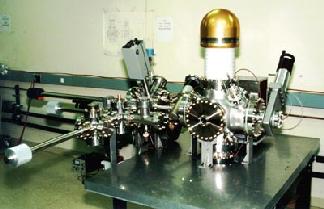Science for the Next Millennium
World's Largest Gathering of Physicists
Take Our Kids to Work Day Features Role Model Visits, Activities, Singer
- PAC 15 Discusses Numerous Topics During Recent Meetings
- Check Out Events; Plan to Observe Earth Day
- Catch Party Highlights on Lab Events Web Page
- Call out the Big Gun!
Science for the next millennium
Task Force studies new lab designed to explore nuclear "chemistry"
by James Schultz
For billions of years, unstable suns have been erupting in vast explosions that race across dust-churned reaches of interstellar space. These supernovae bursts produce a menagerie of unstable, evanescent atomic nuclei that even today remain unknown to contemporary science.
To identify and examine exotic nuclear "isotopes," researchers from distinguished American universities, Dept. Of Energy national laboratories, and research institutes in the United States and abroad are calling for the creation of an advanced ISOL (Isotope Separation On-Line) facility. The DOE's long-range nuclear physics plan identifies such a facility as the highest construction priority for the Department.
In October 1998, at the request of DOE and the National Science Foundation, the Nuclear Science Advisory Committee (NSAC) commissioned an ISOL Task Force to review the research community's readiness to develop, plan and design an advanced ISOL facility. Two members of Jefferson Lab are at the forefront of the group: Lab director Hermann Grunder serves as the ISOL Task Force chair and JLab Accelerator Division scientist Charlie Reece provides critical assistance to Grunder in his role as chair.
The planning group is composed of a dozen members, including ISOL experts from CERN, Geneva, Switzerland; and TRIUMF, Canada's national lab in Vancouver, BC. Additional consultants from France, Great Britain, Japan, Finland, and DOE laboratories are also involved. This past January, ISOL members and consultants met at JLab to address the complexity of typical ISOL target designs. This coming October the Task Force is expected to provide its final report to NSAC.
"If a next-generation ISOL can be built at reasonable cost, it would make an astounding difference in a number of fields, from nuclear physics to astrophysics," says Jefferson Lab director Hermann Grunder. "It should substantially deepen our understanding of elements and their formation. It will change our textbooks."
An ISOL center would explore what some have called the "chemistry" of nuclear physics. The facility would provide to researchers high-intensity, high-resolution accelerated beams of rare radioactive ions, many of which are thought to normally exist only briefly as a byproduct of stellar explosions. An ISOL facility would use an accelerated drive beam comprised of either protons or stable heavy ions to strike a thick target, producing the desired exotic nuclei. The targets are designed to quickly release these ions so they may be separated, fed through a post-accelerator and delivered to experiments before the ions have had time to decay.
An advanced ISOL laboratory should significantly deepen understanding of the nucleus as a "many-body" system built of protons and neutrons and governed almost exclusively by one of the four known forces, the strong nuclear force. Such a laboratory would also test the limits of what is known as the Standard Model: that theory that represents present understanding of the basic laws that govern the way elementary particles interact.
Key Applications
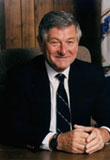 Hermann Grunder ISOL Task Force Chair |
Using the ISOL beam, researchers would be able to focus on the unusual properties of loosely bound quantum systems, especially those with unique geometries. Some nuclei, for instance, are characterized by particle halos or by "skins" of neutron matter. Others interact not just within the nucleus, but outside it as well. ISOL investigations could also examine novel states involving superfluidity and new forms of atomic shell structure.
In particular, ISOL studies should be of benefit to the field of nuclear astrophysics. Processes central to the synthesis of the elements in stars and to the detonation of supernovae are thought to be crucial to life, climate and geology. A star's nuclear reactions involve proton and neutron capture which, in turn, are dependent on the formation and action of unstable nuclei. Study of those nuclei should deepen understanding of the synthesis of elements within stars and the ways in which stars develop and mature.
In the short term, the ion beams produced by a major ISOL facility could have a wide variety of applications to medicine and to industry. In the case of medical treatment, for instance, estimates are that one out of three hospitalized patients in the United States undergoes diagnostic procedures involving nuclear medicine. In the case of diagnostic implants that require a specific radioactive source, an ISOL facility ion beam would offer a range of energies, half-lives and decay types, which can be used to control the depth, intensity and location of implantation. These same characteristics could also be used as diagnostics to boost the efficiency of microchip manufacture and to improve the properties of metals and other materials.
Thus far, Oak Ridge and Argonne national laboratories, with assistance from existing, albeit modest ISOL facilities in Europe and Canada, have actively pursued ISOL feasibility studies, supporting their research with in-house discretionary funds. DOE, however, is planning to direct $10 million to ISOL-related research and development in fiscal year 2001.
If policymakers opt to continue with the project, construction could begin as early as 2002. For the full facility presently envisioned, total costs should run in the neighborhood of $400 million, with facility staffing levels projected to be roughly half those of Jefferson Laboratory's complement of 600.
World's largest gathering of physicists
American Physical Society celebrates 100 years
The largest physics fair in the world took place in Atlanta, Ga., March 15 - 26. Nearly 30 Jefferson Lab staff attended the centennial celebration of the American Physical Society (APS), presenting papers, participating in seminar discussions and attending the large exhibition chronicling the history of the APS.
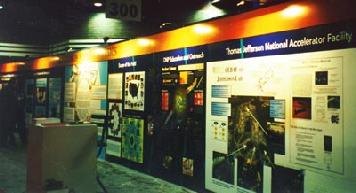 The Division of Nuclear Physics Display presented information about JLab, RHIC, science education, applications of nuclear science and other nuclear physics fields. |
Nearly 11,000 physicists (almost double the projected attendance), including 50 Nobel laureates, from around the world gathered at the Georgia World Congress Center for the APS meeting. In addition to sessions where physicists discussed things like "Electron Deuteron Elastic Scattering in a Simple NN Potential with Excluded Spurious States: Non-relativistic Calculations," the event also featured public events on the physics of beer, baseball, dance, brass musical instruments and Star Trek. Nobel winner Stephen Hawking gave a free public lecture on "The Universe in a Nutshell" at the Atlanta Civic Center.
Ten papers dealing with the results of nucleon-resonance excitation investigations conducted in Hall B were presented during the APS meeting. The Hall B experiments focused on three of the six known flavors of quarks: up, down and strange. Scientists are attempting to better comprehend the interactions between those quarks and the gluons holding them together to form protons and neutrons.
The results of Hall A investigations to determine deutronic structure were also presented at the meeting, as was a paper detailing the outcomes of Jefferson Lab's nucleon-form-factors related investigations. Results determined that the quark-carried charge distribution on a proton is larger than its magnetic distribution. Currently, the reason for the disparity is not known or understood. "Everybody assumed that both the charge distribution and the magnetic distribution were the same," said Hall A leader Kees de Jager. "So the theorists didn't pay much attention. Now that we know both are different, we have to find an explanation. Our work has definitely generated a lot of interest."
While the findings do not appear to challenge the basic tenets of current quantum chromodynamics theory - theory can't yet account for whatever underlying mechanism is responsible for the size difference in charge and magnetic distribution. In any case, the Lab's findings are generating both attention and enthusiasm among theoreticians and experimentalists. Researchers at the Lab and elsewhere will have their hands full trying to solve the mystery.
Additional form-factor experiments have been planned which will probe the proton charge distribution within even smaller spatial resolution.
Syracuse University professor of physics Paul Souder, a primary Hall A Proton Parity Experiment architect and co-spokesman for the international HAPPEX team presented the results of their first round of HAPPEX experiments during a poster session at the meeting. "We were able to rule out the more exotic measurements of the contributions of the strange-quark content of the proton," said John Michael Finn, HAPPEX co-spokesman and College of William and Mary physics professor. "We have plans for future measurements to look at other nuclei. The eventual goal is to map the strength, the flavor currents in the nucleus; and how much up, down and strange quarks contribute to the nucleon's structure."
A second, more stringent round of HAPPEX experiments are slated to start at JLab this month and run through August. "We now have the tools to take HAPPEX further," Finn said. "We'll be conducting a systematic and rigorous program, but on the scale of years rather than decades."
Cynthia Keppel, JLab staff scientist and assistant professor or physics at Hampton University, presented results of an experiment delving into the phenomenon known as quark-hadron duality.
In their own words
A life in physics with Michelle Shinn, FEL scientist
Interview by James Schultz
Why a career in science? When I was little, I used to ask my mother why this and why that. Sometimes she'd get frustrated with me. I've always wanted to know why. When I was in 7th grade, I took a physical sciences course and said: This is it. This is the science I want to do. It was a real eye-opener. I knew what I wanted to do early on.
As a child of "why?" you can always answer "Because of this" - not just "Because." The little answers add up to a bigger solution that can really affect people's lives. Physics explains at a more fundamental level how things work. If you take chemistry, geology, biology, astronomy, cosmology - just about anything - and you keep carrying it back, you get to physics. However, my math friends say if you carry it back even further it either becomes mathematics or religion!
What is your perspective on women in science?
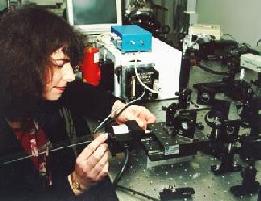 Shinn sets the path length of the autocorrelator in the FEL User Facility's optics control room. |
Women tend to be excluded from the physics ranks. Much of this is cultural. The cultural climate can switch you off from high-tech stuff. It's still not considered feminine in our culture to pop the top off a piece of equipment and mess around inside. Although, at our house, my mom and I used to fix air conditioners, heaters and garbage disposals together.
In the United States, a girl's interest in science depends on how she is treated in the home, in grade and middle school and in high school. In terms of teaching physics at the college level, I think the U.S. and Great Britain are among the countries with the lowest percentages of women faculty - about five percent.
The bias has been unconscious in many ways and overall, seems to be decreasing. I personally haven't experienced bias here at the Lab. We have a younger staff. They're more used to female scientists. And they may have a spouse in a technical field. Or they went to school with women physicists.
What brought you to Jefferson Lab?
I came here in 1994 as a visiting research scientist from Bryn Mawr College, where I was an associate professor of physics. Six years earlier, when I arrived at Bryn Mawr, there were a lot of expectations that I conduct research and teach, both of which I loved and wanted to do. But when you combined the two, I was working 90 hours a week. There was no time to have a social life. I said to myself: This is ridiculous. There weren't enough hours in a day or days in a week to do it all. So here I am.
What attracted you to a career in laser development and research?
When I was in college I realized I would work with lasers for the rest of my life. It's a practical, beneficial technology that derives from basic physics. That's the best place to be for me.
A lot's happened in the last 10 years in terms of lasers. You now have a bunch of little lasers that work in telecommunications, in laser printers, in CD-ROMs and in DVDs. Then you have big lasers like the FEL. When you think about it, the JLab FEL is pretty amazing. It came on-line in just two years.
What is your perspective on the FEL?
I go to these conferences on laser applications and people are constantly talking about getting the weight of a car down. If we can scale up the FEL as we think we can, it will be possible to really affect the way a car is manufactured, from making components lighter to making them stronger and more corrosion-resistant.
We've shown that high average power is possible with an FEL built around an SRF accelerator with energy recovery. Soon we'll be taking the next step: 10 kilowatts of power. One of the big goals is to make an FEL capable of megawatts.
One of the greatest things about research is becoming involved in new fields. For me, the new area is ultrafast physics, which is the physics occurring when a beam of light hits a material and then observing how that material reacts in the first trillionth of a second.
I'm having so much fun with this because the FEL is the next technology in lasers. It is an enormous advance. How many people in the world are building optics for high-average-power FELs? It's certainly not many. If you get right down to it, we're the only ones in the world with this kind of FEL. It's a really stimulating environment. What a thrill! I'm really lucky.
Editor's note: This is the first in a series of stories from the individual perspectives of Lab staff.
What's cooking?
Woodard earns promotion to district executive chef
by Ruth Bizot
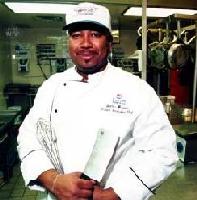 What, chicken again? For most chefs, those would be discouraging words. For Chef James Woodard, they're a welcome challenge. Since February 1998 Woodard has served as executive chef of the Lab's food services unit. Together with manager Judi Sarkis Casto, it's his job to satisfy the temperamental taste buds of Jefferson Lab's diverse and often demanding cafeteria customers.
What, chicken again? For most chefs, those would be discouraging words. For Chef James Woodard, they're a welcome challenge. Since February 1998 Woodard has served as executive chef of the Lab's food services unit. Together with manager Judi Sarkis Casto, it's his job to satisfy the temperamental taste buds of Jefferson Lab's diverse and often demanding cafeteria customers.
And these days, Woodard has more on his plate than just pleasing picky eaters. Last February he was promoted to District Executive Chef, one of only 10 chefs so honored in Eurest Dining Services' eight-state Southeastern Region. Eurest operates the JLab unit, which handles all the Lab's cafeteria and catering needs. The goal of the newly-created executive chef positions is to provide culinary leadership for the region's more than 200 units. In addition to their regular duties, Woodard and his cohorts will present special events throughout the region, and provide training and guidance when new units open. Last month he helped orchestrate a VIP food show at First Union Bank's Charlotte, N.C., headquarters.
At 31, Woodard is the youngest of the 10 chefs selected. He's quick to share the credit. "It's a team thing," he says. "Jefferson Lab is one of the smaller units, and yet we're on the map in the region. That's definitely an honor." Some units have staffs of 40 or more; JLab's has only four full-time people.
Ten years as an Army chef taught Woodard the fundamentals of his craft. Not content with basic training, he also studied local cuisine at each new duty station. But while the service took him from Korea and Japan to France, Germany, Spain and Russia, it couldn't take him where he really wanted to go. "I was hungry for more culinary mileage than the Army would allow," he said.
So, trading olive drabs for civilian whites, Woodard enrolled at Johnson & Wales University's Norfolk campus. With a little help from the G.I. Bill and a hefty student loan, he completed an accelerated one-year program and received an associates degree in culinary arts in June 1996.
His passion for cooking is two-fold. First there's the creative urge to combine foods and flavors in delicious new ways. "It's almost like being a scientist or a physicist or a chemist," Woodard says, "coming up with something that's never been explored before."
Then there's his love affair with his audience. "Seeing someone immediately gratified by something that I've created," Woodard explains. "The oohs and aahhs, the amazement of 'How did he do that?' and 'What is in this?'" That's what really keeps him cooking!
Take Our Kids to Work Day features role model visits, activities, singer
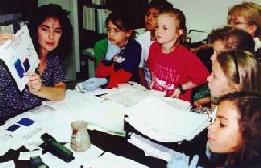 The Lab's Take Our Children to Work Day in honor of National Take Our Daughters to Work Day is set for Thursday, April 22. The registration deadline is April 19.
The Lab's Take Our Children to Work Day in honor of National Take Our Daughters to Work Day is set for Thursday, April 22. The registration deadline is April 19.
The event is open to all Lab employee children (immediate family only) between third and eighth grades. Youth will meet with Lab role models from 8:45 -11:30 a.m. then lunch with their parent(s). The afternoon includes science and math activities, and a special session with college physics instructor and science entertainer Lynda Williams. Her performance starts at 3:45 p.m. and will include science-based songs to pop or well known tunes.
Contact the Education Group at ext. 7164 to register your child/children for the day. Education is seeking volunteers to act as role models, and escorts to lead small groups of students between the role models' offices. For more information or to volunteer your help, call Education Program manager Jan Tyler, ext. 7164/7560.
Run-A-Round nears
Event becomes Lab's rite of spring
It's time to pull out the shorts and dust off the tennis shoes! Yes, Jefferson Lab's 14th annual Run-A-Round is almost here. Thursday, May 6 is the big day.
The event is open to all Lab employees, their family members, contractor employees and users/collaborators. Registration forms will be distributed to all Lab mail boxes. JLab Activity Group (JAG) members will have extra sign-up forms. To make the event truly successful, everyone needs to participate, says Dave Williams, JAG chair. "This event offers something for everyone."
As in past years, the Peninsula Track Club will oversee the fun run/walk. However, volunteers are needed to help the track club with pre-registration, tracking racers' times, monitoring critical points along the race course, and staffing the water stop at the half-way point and the water and fruit stop at the finish line.
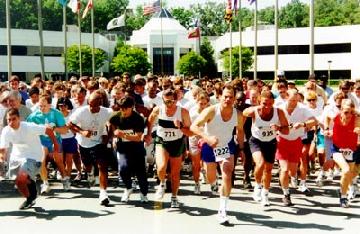 Last year's Run-A-Round drew nearly 350 participants - a new record for the annual event! |
If two or more teams sign up for the relay, that event will begin after the Run-A-Round. Specifics about registration, the course, relay teams, age categories and awards will be on the Run-A-Round registration form.
All registered finishers of the Run-A-Round or relay race will receive the 1999 Jefferson Lab T-shirt, which will be unveiled just before the start of the race. Volunteers will be needed to help with T-shirt distribution.
The Golf Cart Parade takes place after all racers are finished. Start thinking now about the best way to "decorate" your office or department golf cart. After golf cart judging, food and entertainment will be available outside the Residence Facility. Race results will be announced as soon as they have been tabulated.
Volunteers are also needed to help with food and drink service and with clean-up. For more information about the event or to volunteer, call Dave Williams, ext. 7183.
PAC 15 discusses numerous topics during recent meeting
The Jefferson Lab Program Advisory Committee (PAC 15) met January 26-30 to hear about the progress of the Accelerator and all three Halls, as well as run plans for the Halls.
The committees also discussed new and updated proposals and letters-of-intent, the first of the jeopardy proposals, and the modifications in procedures and policies that have been implemented at the Lab in the wake of the termination of the experimental run of GEn in Hall C. The focus of there discussions was on how to avoid similar problems in the future and on the importance of future measurements of the GEn.
In what is expected to be a continuing series, the second PAC workshop addressed the status and experimental opportunities in measurements of the nucleon and meson form factors and nucleon sum rules. The committee reviewed and made recommendations on 16 new proposals and three letters-of-intent.
Lab director Hermann Grunder offered a special "thank you" to Brad Filippone, California Institute of Technology, for the leadership he provided as chairman of PACs 11-15. PAC 15 member and current Users Group Chair Don Geeseman, Argonne National Lab, will serve as PAC 16's chair.
PAC reports are available at http://www.jlab.org/exp_prog/PACpage/
Check out events; plan to observe Earth Day
April is both Earth Month and Keep Newport News Beautiful Month; and Earth Day is April 22.
Newport News is again sponsoring a series of events to celebrate Earth Month and increase environmental awareness and protection. The following events are scheduled this month:
- April 17: March for Parks, 9 a.m. - noon
- April 24: The City's Earth Day event, 11 a.m. - 3 p.m. and the evening Litter Free Night at Harbor Park
Contact Al Cousineau at 249-5777 to participate in any of these events.
Sixty-six groups currently participate in the City's Litter Free by 2003 adopt-a-spot program. If you, or any organization you're part of, want to adopt an area let Al Cousineau know. Does JLab want to adopt a spot, asks Linda Even, Lab environmental engineer, ext 7308.
For more information about Earth Day visit the Earth Day Network web site at: http://www.earthday.com
Catch party highlights on lab events web page
Catch photos and highlights from the Lab's March Madness Mardi Gras by visiting the Lab's news web page at http://www.jlab.org/news/. Go to the lower left corner of the news web page (On Site Only) and select Lab Events, or you may go to it directly at: http://www.jlab.org/news/labevents/.
Due to limited space in the Lab's monthly newsletter, it isn't always possible to cover these events in ON TARGET. Public Affairs uses the web page to share this information with Lab staff and users. If there's an event or activity you would like to see on the Lab Events web page, call Linda Ware, ext 7689.
Work is underway in the Experimental Equipment Lab on a new polarized beam gun for the Accelerator. Engineer Bill Schneider and High Vacuum associate Phil Adderley are building the Prototype Load Lock Polarized Source (gun) using best technology practices and components. Schneider and Adderley gave a poster presentation on the new gun and its many innovations during the Particle Accelerator Conference in New York City, March 29- April 2.
Madonna of Science
Entertainer plans evening of high-tech song at Lab
A new act is coming to Jefferson Lab for the April 22 Science Series.
By day Lynda Williams is a physics instructor at San Francisco State University. But after dark she becomes a science entertainer who has been dubbed "the Madonna of Science" or "Physics Spice" as she belts out her own lyrics to the tunes of show hits and popular songs.
Her lyrics are what make her unique in the entertainment world. She sings about science! "I think so many subjects in science are interesting and fascinating that they have intrinsic entertainment value," she recently told a reporter.
Her version of Madonna's Material Girl goes: Some boys kiss me, some boys hug me / I think they're passé / if they can't talk about quantum theory / I just walk away...
Chorus: We are living in a high tech world / and I am a high tech girl...
She also has her own version of Marilyn Monroe's "Diamonds Are a Girl's Best Friend." Williams' refrain is "carbon is a girl's best friend."
The physics chanteuse will treat her audience to a better understanding of the science behind Jefferson Lab through song during her performance in the CEBAF Center auditorium beginning at 7 p.m. on April 22. The event is free and open to students and adults with an interest in science.
Last month she performed at the American Physical Society conference in Atlanta, Ga. She peppers her performances with dance, and science-related jokes and overhead slides.
Bright Spot on the Web
Editor's note: If you have or know of a web site that could be informative or useful to Jefferson Lab staff, call the public affairs office at ext. 7689 or e-mail Linda Ware (ware@jlab.org).
If you are planning a business trip or vacation to Europe, bookmark this site: www.eurorail.com/railindx.htm. It is a one-stop information source on the most-used form of travel throughout Europe - the train. The European rail system is second to none, and this web site makes planning and scheduling easy. The main page offers many choices: frequently asked questions (FAQs), planning maps, international airports with train connections and distances & travel times. The web site even offers advice on how to pack.


